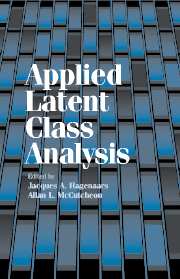Book contents
- Frontmatter
- Contents
- Contributors
- Preface
- INTRODUCTION
- CLASSIFICATION AND MEASUREMENT
- CAUSAL ANALYSIS AND DYNAMIC MODELS
- UNOBSERVED HETEROGENEITY AND NONRESPONSE
- 12 A Latent Class Approach to Measuring the Fit of a Statistical Model
- 13 Mixture Regression Models
- 14 A General Latent Class Approach to Unobserved Heterogeneity in the Analysis of Event History Data
- 15 Latent Class Models for Contingency Tables with Missing Data
- Appendix A: Notational Conventions
- Appendix B: Further Readings
- Appendix C: Selected Software; Webpage
- Index
13 - Mixture Regression Models
Published online by Cambridge University Press: 31 July 2009
- Frontmatter
- Contents
- Contributors
- Preface
- INTRODUCTION
- CLASSIFICATION AND MEASUREMENT
- CAUSAL ANALYSIS AND DYNAMIC MODELS
- UNOBSERVED HETEROGENEITY AND NONRESPONSE
- 12 A Latent Class Approach to Measuring the Fit of a Statistical Model
- 13 Mixture Regression Models
- 14 A General Latent Class Approach to Unobserved Heterogeneity in the Analysis of Event History Data
- 15 Latent Class Models for Contingency Tables with Missing Data
- Appendix A: Notational Conventions
- Appendix B: Further Readings
- Appendix C: Selected Software; Webpage
- Index
Summary
INTRODUCTION
The development of mixture models dates back to the nineteenth century (Newcomb, 1886). In finite mixture models, it is assumed that the observations of a sample arise from two or more unobserved classes, of unknown proportions, that are mixed. The purpose is to unmix the sample and to identify the underlying classes. Mixture models present a model-based approach to clustering. They allow for hypothesis testing and estimation within the framework of standard statistical theory. The mixture model approach to clustering moreover presents an extremely flexible class of clustering algorithms that can be tailored to a very wide range of substantive problems. Mixture models are statistical models, which involve a specific form of the distribution function of the observations in each of the underlying populations (which is to be specified). The distribution function is used to describe the probabilities of occurrence of the observed values of the variable in question. The normal distribution, for example, is the most frequently used distribution for continuous variables that take values in the range of minus infinity to infinity. The binomial distribution describes the probabilities of occurrence of binary (0/1) variables, and the Poisson distribution the probabilities of occurrence of discrete (count) variables. Certain classes of mixture models based on the latter two distributions have become known in the literature as latent class models. Lazarsfeld and Henry (1968) provide one of the first extensive treatments of this topic.
- Type
- Chapter
- Information
- Applied Latent Class Analysis , pp. 366 - 382Publisher: Cambridge University PressPrint publication year: 2002
- 16
- Cited by



